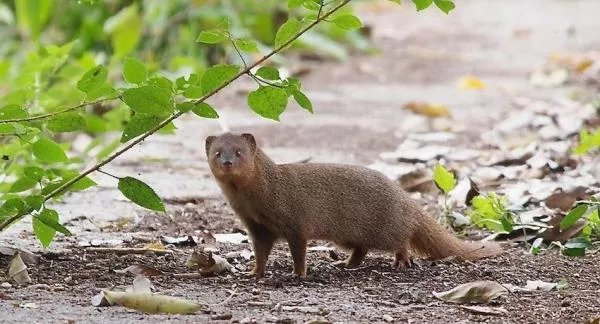
Regarding the environmentToo often humans have the bad habit of disrupting, and not precisely for the better. As individuals, there is of course everything, but if we focus on excesses, the human species is a real problem for this planet.
As it is, the species suffer us. Because of us, many of them are against the ropes, on the way to extinction or directly extinct and, on the other hand, the opposite occurs: an induced proliferation as a consequence of imbalances of the ecosystem caused by us.
It is, in effect, its introduction into new habitats out of unconsciousness or for utilitarian purposes. The examples are innumerable, but they all have in common the creation of a problem in which, applied exterminating measures, it is the animals that end up losing. Ultimately, the so-called "invasive species" end up being doubly victims.
Invasive Species: The Neverending Story
Since the dawn of time, walking from here to there, in a nomadic plan first, and then through trade and migration, have caused important changes in ecosystems. And invasive species have been one of the main victims, in addition to the native ones, which are sometimes defenseless against them.
Flora and fauna introduced by humans are here and there, throughout history, but especially today, has caused serious problems of ecological balance, since the presence of invasive species pose a significant threat to it.
In addition to hunting and the destruction of the environment, therefore, human action also threatens ecosystems with the introduction of foreign species.
It is a thorny issue that is the focus of the International Union for Conservation of Nature (IUCN). Through its Species Survival Commission it has made a list of the most harmful invasive alien species in the world.

10 invasive species
In this post we focus on the fauna. Next, we will see a random selection of a dozen animals whose presence in ecosystems that are alien to them causes problems. The casuistry is very varied, but the essence of the problem is repeated.
It goes without saying that when extermination his right life is not taken into consideration at all. After being classified as pests, their captures are usually given free rein.
Parrots
The parrots arrived in Spain as exotic pets in the 70s and since then those that escaped and were released voluntarily began to reproduce. They currently number in the thousands. Above all, they belong to the species of Argentine parrot (Myiopsitta monachus) and Kramer's parrot (Psittacula krameri)

Gray squirrel
Gray squirrels are reducing the territory of the red squirrels in the United Kingdom, these being the autochthonous and those considered invasive. Their introduction was made by humans, who kept them as pets, coming from the United States.
Plasmodium relictum
Avian malaria was spread through exotic birds brought to Hawaii by settlers. Its expansion occurred through a mosquito, the Culex quinquefasciatus, which arrived in 1826 by sea, specifically in the barrels of water from a boat.
Avian Malaria, together with this vector, led to the extinction of numerous native bird species that lacked resistance, and continues to do so in different areas of the planet. Plasmodium relictum, for example, is also responsible for infections from species of birds in Peru.

Wild pigs
Feral pigs were originally domestic animals that, either by escaping or releasing them, thrived in their new environment and ended up becoming part of the environment. The Sus scrofa species is part of the list that includes the 100 most harmful invasive alien species in the world, prepared by The Global Invasive Species Database, based on information from the IUCN.
Javanese mongoose
The Javanese mongoose (Herpestes javanicus) hails from Iran, India, the Malay Peninsula, and Myanmar, and was introduced in the late 19th century to control rats. Its irruption in the ecosystems of Mauritius, the West Indies and Hawaii became a big problem, since it caused the extinction of different species.

Brown tree snake
It is a species indigenous to Australia, Papua New Guinea, the Solomon Islands and Indonesia. He is believed to have arrived on Guam, an island in the Western Pacific, as a stowaway on a military plane. It was in the middle of the last century, and by the 70s it had expanded. Its danger lies, above all, in constituting a threat to the diversity of this and other islands with a tropical climate.
Burmese pythons in the Everglades
The overpopulation of python snakes Burmese in the Everglades National Park is a problem that has gone around the world. Reducing the presence of invading reptiles, pets or descendants of pets, does not end the environmental drama that they pose.

Florida turtle
Also know as tortoise from Florida, they are one of the most popular pets that could be found in pet stores a few years ago. Trachemys scripta is now banned from being introduced throughout Europe to prevent uncontrolled release, since they cause damage to ecosystems.
The Gambusias
They are tiny little fish, from the fresh waters of the eastern and southern United States. The problem was created by humans with their intentional introduction to control mosquitoes. While effective, the indigenous predators They were no less so, expert voices say. They began to be introduced at the beginning of the last century and continue to be done.

Nile perch
The introduction of the Nile perch (Lates niloticus) in Lake Victoria in 1954 to increase the fishery resources, depleted by overfishing, was not a good idea. On the contrary, since their arrival the extinctions of indigenous fish multiplied and chain reactions took place that were disastrous for the ecosystem and for the local subsistence economy.
On the one hand, the deforestation to dry the catches of this perch. On the other hand, the excess of organic residues caused a plague of algae that reduced the oxygen in the water, triggering the death of the fish.
If you want to read more articles similar to 10 animals we've turned into invasive species, we recommend that you enter our Wild Animals category.


